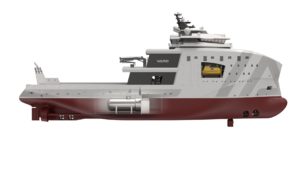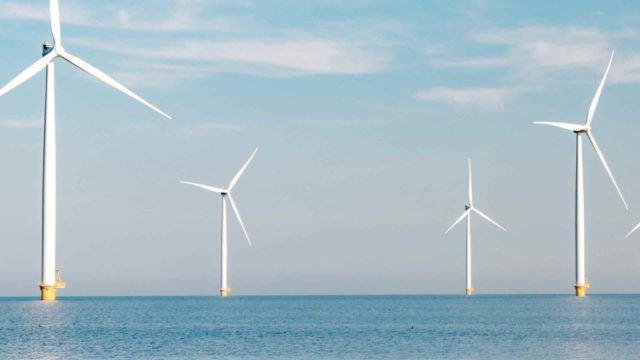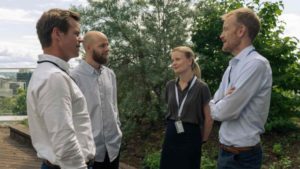Energy produced from offshore wind turbines will help increase overall energy production in Norway. The country’s total need for energy in 2050 will be about twice what it is today – according to DNV’s Energy Transition Outlook. The government’s ambition is to produce almost as much new power from offshore wind as we currently produce in total in Norway. This will mean around 1500 offshore wind turbines over the next 20 years. The first major areas for offshore wind have already been launched – Utsira North and North Sea II. at south
Fred. Olsen Seawind and Hafslund have established Blåvinge as a long-term partnership. Blåvinge’s goal is to help achieve these overall goals. More concretely, the goal of the partnership is to develop offshore wind into a new Norwegian industry and an important source of renewable energy. This applies to both bottom-fixed and floating turbines. But for new energy to be produced as sustainably as possible, the installation and operation of offshore wind turbines must also be emission-free.

Vard has designed a zero-emission anchor handling tug supply vessel (AHTS) – a potential ammonia-powered installation vessel for offshore wind. Illustration: Vard.
Offshore fleet in general, and especially the “anchor handlers,” have high fuel consumption. Today; marine diesel. For Norwegian domestic shipping, nearly a quarter of greenhouse gas emissions come from the offshore fleet. Emissions from these vessels must be reduced. The Parliament has asked the government to introduce low-emission requirements for offshore vessels with the aim of implementation from 2025 and that this should result in zero emissions from the same types of ships by 2029.
When the demand for new builds in this segment is expected to increase, new opportunities are created.
Will future offshore vessels, and especially “anchor handlers,” be able to use green ammonia as an energy carrier for maritime operations?
In addition to the partners listed on the right, Azane Fuel Solutions, a 50%-owned subsidiary of Amon Maritime, is also involved in the pilot.

The driving force of the pilot project
Blåvinge wants to explore green ammonia as an energy carrier in offshore wind operations based on:
- Norway has particularly favorable conditions for the production and distribution of green ammonia
- The fuel appears promising for the AHTS segment due to characteristics such as higher energy density and easier storage than several of the alternatives.
Through this pilot project, the participants will seek to seize the opportunity the green shift represents for Norwegian suppliers by:
- Develop green solutions with great potential for export to the global offshore wind market.
- Reduce emissions from the group of vessels responsible for the largest discharge item in Norwegian waters.
- Develop green fuel infrastructure that will also benefit other industries.
The goal is that the installation of offshore wind turbines can be done with significantly lower greenhouse gas emissions than is possible today.
The goal of the pilot study
The objective of conducting this pilot study is to explore opportunities and barriers for realizing zero-emission solutions for the installation and operation of floating offshore wind turbines.
Furthermore, the pilot study seeks to contribute to realizing the political goals of the offshore wind initiative and thus what the pilot participants consider to be enormous opportunities for exporting Norwegian technology. Initially, participants in this GSP pilot will do a feasibility study that involves assessing technical and economic feasibility. The pilot participants will also look at framework conditions and possible barriers for local ammonia value chains.
The pilot study will:
- Assess the technical and economic feasibility of the development of an ammonia battery hybrid AHTS, and necessary bunkering solutions
- Assess ship technology and design, bunkering systems in port and fuel availability
- Assess framework conditions for realization
- Identify barriers and risk mitigation measures
The main activities of the study will be to:
- Identifying ammonia value chains
- Explore port and logistics solutions, including bunkering and charging
- Develop a ship design, including tank placement, propulsion and system integration
- Assess framework conditions for realization
- Explore financing options
- Compile the results and assess the business case for the actors involved
Finally goal of the pilot
The ambition is that the pilot project will enable the use of green ammonia for anchor handling vessels in the installation and operation phase of Blåvinge’s floating offshore wind project on Utsira North.
With such an ambition, emissions from the maritime operations for the development and operation of Utsira North and floating offshore wind in general will be reduced to a minimum.
The pilot’s long-term goal is to lay a foundation so that Norway’s advantageous position can be further developed and strengthened, and thus contribute to creating a market for green ammonia. This can be achieved by establishing local ammonia value chains that enable the use of ammonia-battery-hybrid anchor handling vessels in the installation and operation phase of an offshore wind farm.
The ultimate goal of the pilot is to make zero-emission solutions available for the installation and operation of floating offshore wind at the Utsira North area by establishing critical local ammonia infrastructure utilized by an ammonia- battery-hybrid AHTS vessel. In other words; both filling station and ship.
Status
The pilot study was completed and finalized early in 2025.
The study was conducted as an investigative work and is compiled in this final report.
The study has assessed:
- Technical and economic feasibility for the development of the vessel and bunkering solutions
- Framework conditions for realization
- Ship technology and design
- Bunkering system in port
- Availability of fuel
- Barriers and risk-reducing measures
The pilot assessed an AHTS (anchor handling tug supply vessel) powered by ammonia and battery, for operation between the Utsira Nord offshore wind farm and Karmsund port during the installation phase for the upcoming wind turbines. The study looked at technology, design, bunkering, and framework conditions, with a focus on barriers and possible measures.
With the aim of achieving a positive business case early on, a standard AHTS design was chosen. Such a vessel could also be used in other industries in the first years after 2030.

Harald Gundersen and Erlend Gjelstad Jakobsen, both from Blåvinge, along with Eirill Bachmann Mehammer and Magnus Eide from DNV, at the start of the pilot.
Ørsted, originally part of Blåvinge, withdrew from the Norwegian offshore wind market in the spring of 2024. This did not affect the ambition of the pilot study.
Ship design concluded early in the pilot study that 300m³ of ammonia would provide 5 days of operation on 5 DF ammonia engines. This is technically feasible, but the challenge will be to account for costs and fuel prices.
Ship Design: An innovative ship concept was developed that should provide very high flexibility and the ability to serve multiple markets.
The outlined anchor handler will significantly reduce CO2 emissions (>70%) during operation.
Port/Logistics: The design of bunkering solutions was developed in the form of a bunkering barge. The barge has already been approved by the DSB.
Ammonia Value Chain: There is limited availability of green power to produce green ammonia.
Investment case and rates: An AHTS, as outlined by the pilot, will be expensive. Approximately 2 billion NOK. Increased investment costs by using ammonia are estimated at 400 million NOK. The average daily rate for an anchor handling tug supply vessel in the North Sea in 2024 was approximately 575,000 NOK. The necessary daily rate for the pilot’s outlined AHTS will amount to a minimum of 1.2 million, possibly more depending on the discount rate.
Framework Conditions and Instruments: The CO2 tax will be important, but not sufficient alone to trigger the concept. Enova’s program for ammonia-powered vessels will be highly relevant. There is a need for differential contracts to cover the additional costs associated with operation.
During the pilot’s “lifetime,” Blåvinge’s assessment is that the opportunities for realizing an offshore wind project at Utsira Nord have changed. Therefore, Blåvinge no longer aims to pursue an offshore wind project at Utsira Nord as initially planned.

